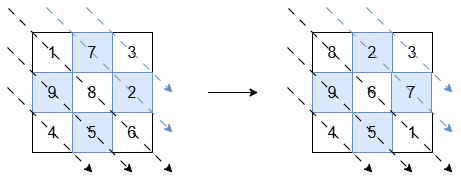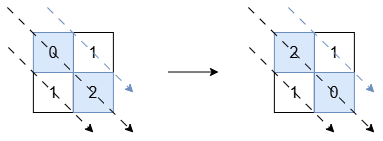3446. Sort Matrix by Diagonals
Description
You are given an n x n square matrix of integers grid. Return the matrix such that:
- The diagonals in the bottom-left triangle (including the middle diagonal) are sorted in non-increasing order.
- The diagonals in the top-right triangle are sorted in non-decreasing order.
Example 1:
Input: grid = [[1,7,3],[9,8,2],[4,5,6]]
Output: [[8,2,3],[9,6,7],[4,5,1]]
Explanation:

The diagonals with a black arrow (bottom-left triangle) should be sorted in non-increasing order:
[1, 8, 6]becomes[8, 6, 1].[9, 5]and[4]remain unchanged.
The diagonals with a blue arrow (top-right triangle) should be sorted in non-decreasing order:
[7, 2]becomes[2, 7].[3]remains unchanged.
Example 2:
Input: grid = [[0,1],[1,2]]
Output: [[2,1],[1,0]]
Explanation:

The diagonals with a black arrow must be non-increasing, so [0, 2] is changed to [2, 0]. The other diagonals are already in the correct order.
Example 3:
Input: grid = [[1]]
Output: [[1]]
Explanation:
Diagonals with exactly one element are already in order, so no changes are needed.
Constraints:
grid.length == grid[i].length == n1 <= n <= 10-105 <= grid[i][j] <= 105
Solutions
Solution: Simulation
- Time complexity: O(n2)
- Space complexity: O(n2)
JavaScript
/**
* @param {number[][]} grid
* @return {number[][]}
*/
const sortMatrix = function (grid) {
const n = grid.length;
const matrixMap = new Map();
for (let row = 0; row < n; row++) {
for (let col = 0; col < n; col++) {
const pos = row - col;
if (!matrixMap.has(pos)) {
matrixMap.set(pos, []);
}
matrixMap.get(pos).push(grid[row][col]);
}
}
for (const [pos, values] of matrixMap) {
values.sort((a, b) => (pos >= 0 ? a - b : b - a));
}
for (let row = 0; row < n; row++) {
for (let col = 0; col < n; col++) {
const pos = row - col;
const values = matrixMap.get(pos);
grid[row][col] = values.pop();
}
}
return grid;
};